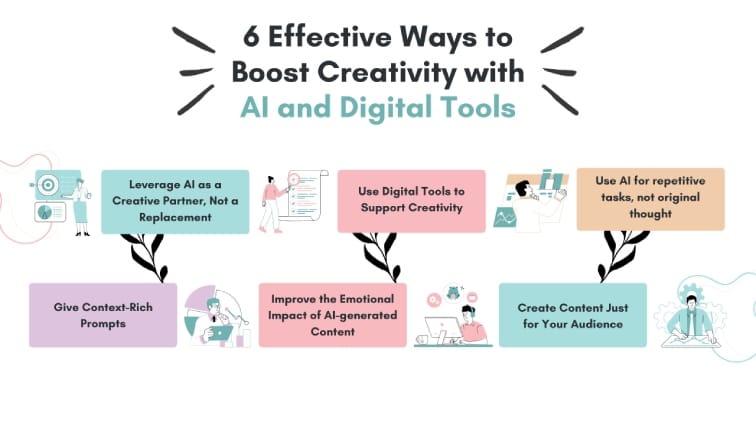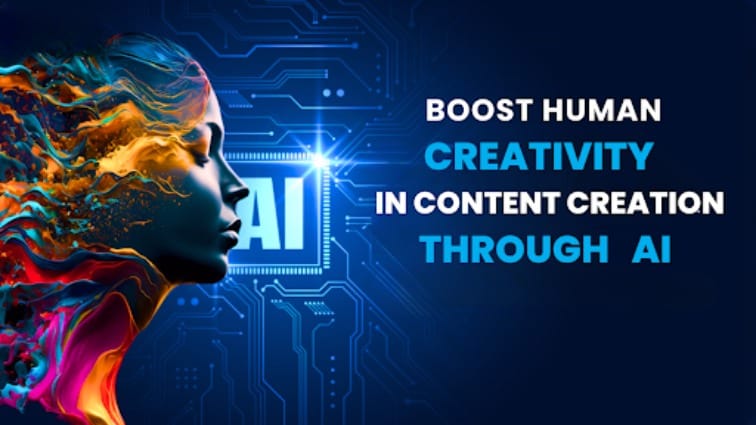Boosting Human Creativity in Content Creation Through AI
The growing integration of artificial intelligence (AI) in content creation raises concerns about the potential overshadowing of the human element in writing.
Even if AI provides strong tools to improve productivity, optimize processes, and even produce content, to produce interesting and genuine content, you still need to add your unique touch.
AI’s role in content creation
AI tools can enhance efficiency by assisting with tasks such as idea generation, content drafting, editing, and search engine optimization. However, AI still falls short in grasping human emotions, context, and cultural subtleties.
To truly benefit from AI in content creation, it’s crucial to view it as a supportive tool rather than a replacement for human creativity. By understanding AI’s limitations, you can leverage its strengths while maintaining the human touch in your content. A digital agency in Chennai can help integrate AI effectively, ensuring your brand’s unique voice and emotional resonance stay at the forefront.

6 Effective Ways to Boost Creativity with AI and Digital Tools
1. Leverage AI as a Creative Partner, Not a Replacement
AI can be a valuable tool in your creative process, but it shouldn’t replace your creative input. Instead, think of it as a helpful assistant. Tools like ChatGPT or Jasper can develop content ideas, suggest improvements, or handle time-consuming tasks, freeing you up to focus on the more creative aspects of your work.
For example, while AI might help generate initial drafts or ideas, your personal touch shapes those into something truly unique and meaningful.
Let AI handle the basics, but keep your creative spark at the core of the final product.
2. Use Digital Tools to Support Creativity
Digital tools don’t have to limit creativity; they can help it flourish. Platforms like Canva, Trello, and make it easier to organize ideas and brainstorm. They allow teams to collaborate seamlessly, freeing up more time to focus on the creative aspects instead of technical challenges.
For example-Canva offers ready-made templates, but you can still tweak them to create something entirely your own. Miro helps teams visually brainstorm together, sparking fresh ideas. These tools support creativity rather than restricting it.
Use tools that streamline the process, but always leave space for your unique touch.
3. Use AI for repetitive tasks, not original thought
AI helps handle repetitive tasks, but it can’t match human creativity, humor, and storytelling.
By letting AI take care of the routine work, you can focus on the creative aspects that need a personal touch.
Automate simple tasks: Use AI for things like gathering data or analyzing trends. This frees up your time to create engaging content.
Start with drafts: AI can provide outlines or draft ideas, but you should shape them into something unique.
4. Give Context-Rich Prompts
To get the most out of AI tools, it’s essential to give them specific instructions instead of vague requests.
For example, instead of just saying, “Write an article introduction,” try something more detailed like, – Create an engaging introduction for a blog post about sustainable fashion that targets eco-conscious millennials, using a friendly and approachable tone.
Keep Your Audience in Mind: Always think about your audience when you’re directing the AI. Make sure your prompts address their needs and preferences so the content truly speaks to them.
Refine the Outputs with Feedback- If the AI doesn’t hit the mark on its first try, don’t hesitate to refine your prompts or add more details. This back-and-forth will help ensure the content generated aligns more closely with your vision.
Keep Your Audience in Mind: Always think about your audience when you’re directing the AI. Make sure your prompts address their needs and preferences so the content truly speaks to them. For instance, if you’re working on online marketing in Chennai, consider mentioning local trends and demographics to help the AI generate more relevant insights.
5. Improve the Emotional Impact of AI-generated Content
AI-generated content can sometimes feel a bit cold or impersonal. While it can produce clear and logical text, it often lacks emotional depth. That’s where human creativity shines.
Add Emotion, Empathy, and Authenticity: After the AI creates the content, take some time to review it and add emotional elements that AI might overlook. Infuse the writing with feelings like empathy, humor, passion, or urgency to make it more engaging.
Use Relatable Language: Swap out any formal or stiff language for a more conversational tone. Speak to your readers as if you’re having a chat with them, making the content feel more personal.
Connect Through Storytelling: Share personal experiences, case studies, or real-life examples to illustrate your points. These stories can help bridge the gap between what AI produces and the human touch that resonates with readers.
6. Create Content Just for Your Audience
AI can suggest ideas based on what people like, but your understanding of your audience makes the content connect. Use AI insights to guide you, but rely on your knowledge of your readers to shape the final piece.
Mix Data with Human Insight: AI can point out popular topics and keywords, but it’s up to you to use this information in a way that truly meets your audience’s needs.
Write Personalized Messages: AI can help you find the right groups of people and propose specific content, but make sure the final message reflects what you know about their motivations and desires.
Stay Authentic: Even when personalizing content for many people, keep your brand’s true voice. Avoid replies that feel overly automated or generic, as these can feel impersonal.
What differentiates human creativity from AI creativity?
Human creativity is deeply personal, filled with emotion, and rooted in our feelings, experiences, and culture. This unique perspective allows people to share ideas and create art, stories, and solutions that connect with others on a meaningful level.
AI, however, generates content based on patterns and data. While it can mimic creativity using learned information, it lacks real emotional depth or understanding. A content marketing agency might use AI to support content creation, but true creativity—marked by intuition, empathy, and inspiration—is something only humans bring. AI can assist in the creative process, but the core of human creativity remains unmatched.
FAQ Question
1. What are some popular AI tools for content creators?
Popular AI tools for content creation include:
GPT-based writing assistants (like ChatGPT, Jasper) for content generation.
Canvas AI features for design and visuals.
Grammarly for language enhancement.
Lumen5 for AI-powered video creation.
Buzz Sumo for content ideas based on trends and analytics.
2. Can AI replace human content creators?
No, AI is not meant to replace human creativity but to complement it. While AI can generate content and assist with certain tasks, human insight, emotion, and experience are irreplaceable elements in storytelling and content creation.
3. How can AI help in improving the SEO of content?
AI-powered SEO tools analyze keywords, content structure, and competitor performance to suggest improvements. These tools help optimize content for search engines by identifying the right keywords, meta descriptions, and readability improvements.
4. How can AI assist in content creation?
AI helps streamline content creation by generating ideas, automating repetitive tasks, and optimizing content for SEO. It provides writing suggestions, enhances productivity, and frees up time for creators to focus on strategy and creativity.
5. What are some AI prompts for content creation?
AI can help generate diverse content like blog posts, social media captions, video scripts, and ad copy. Prompts such as “Write a blog about AI in marketing” or “Create a Facebook ad for a fitness app” can spark creativity. These prompts guide AI to produce relevant and engaging content for various platforms.




